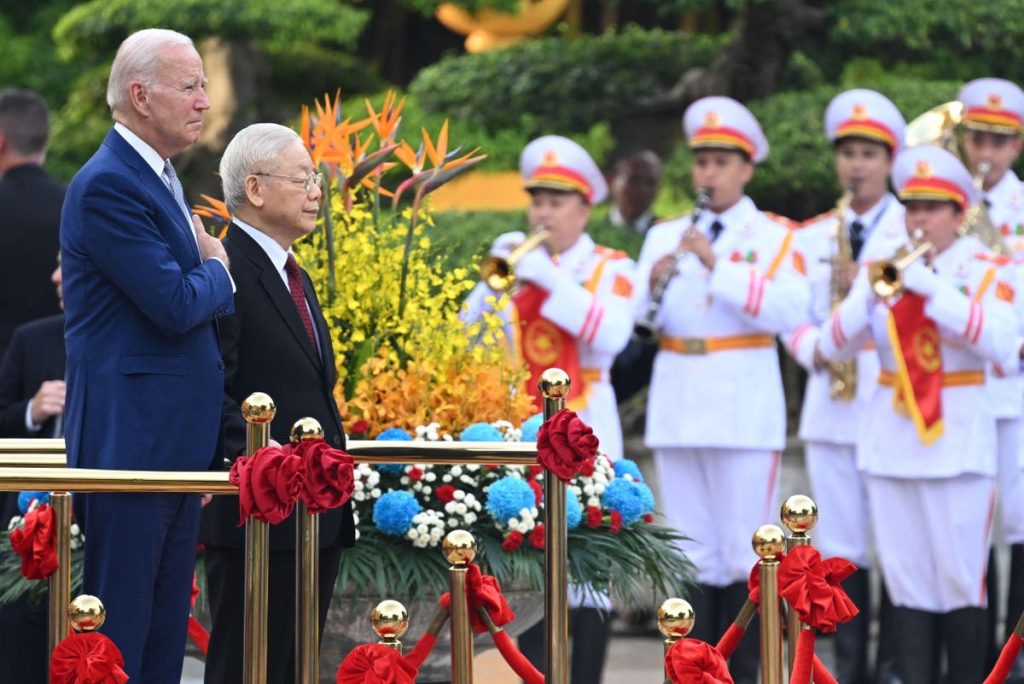In Washington’s competition with Beijing, Joe Biden has recently scored some points. After the recent G-20 meetings in India, he flew to Vietnam and signed an agreement that will bring Hanoi closer to the American side. Not surprisingly, Vietnam is acting cautiously in this matter, but it is clearly a point for Biden. Now it is Beijing’s turn to make move in its tit-for-tat competition with Washington.
This new, so-called “comprehensive strategic partnership” elevates Vietnam and the United States in each other’s diplomatic and economic hierarchies. It gives the United States Vietnam’s highest designation for a foreign partner, up from no status previously and on an even level with Russia and China. Washington has promised to promote Vietnam as a dependable location for U.S. business operations abroad. Significantly, Biden, among the trade pledges, promised to help expand Vietnam’s semiconductor and artificial intelligence (AI) production. The deal will surely accelerate the already rapidly growing level of trade between the United States and Vietnam. Trade between the two economies has doubled during the past five years as western companies have shifted operations from China to Vietnam.
However much this deal benefits the United States and Vietnam directly, it clearly aims at Beijing. For Vietnam, the American connection, though it has limited diplomatic status and no military elements, will give Hanoi leverage in its ongoing dispute with Beijing over Chinese claims for sovereignty over islands in the South China Sea and large stretches of ocean up to 1,200 miles from the Chinese coast. This leverage, of course, is only implied and was certainly never mentioned during Biden’s visit. On the contrary, General Secretary of the Vietnamese Communist Party Nguyen Phu Trong insisted as he signed that in reaching this agreement, his country was “not aligning itself with the United States against China.” Well he might soften the effect in this way. China is, after all, Vietnam’s biggest trading partner and its primary source of essential raw materials.
From the American side, President Biden said that his efforts to improve trade with Vietnam most definitely are not designed to “contain” China. Biden further insisted that “we’re not trying to hurt China.” According to reports
from those who accompanied the president, he repeated these assurances so frequently that it was easy to believe that he meant the opposite. Given American restrictions on the sale of technology to China as well as limits on American investment in Chinese technology, the president’s decision to highlight Vietnamese capabilities in the production of semiconductors and other technologies does seem like a way to punctuate American efforts to disadvantage China. If this implication were not clear enough, Biden, while disclaiming any intention to “contain” China, said that part of his reason for courting Vietnam is to give the United States a “stable base in the Indo-Pacific.” The only reason to seek a stable base would be contain Chinese expansion.
The deal is an additional feather in Biden’s cap. In the tit-for-tat character of Washington’s competition with Beijing, he seemed to score points last year with restrictions on exports of advanced semiconductors to China as well as advanced semiconductor manufacturing equipment. He scored more points by getting Japan and the Netherlands to join the export bans. Over the summer, Washington stepped up the pressure on Beijing with an executive order that will limit American investments in Chinese technology. In a counter to these moves, China recently announced a technological breakthrough in semiconductor production that might render moot the American, Japanese, and Dutch export bans. With this Vietnam agreement, the United States has partially countered the effect of China’s breakthrough by turning Vietnam, a close China trading partner, from a neutral-to-negative posture opposite the United States to a more positive posture. So far, Beijing has said little but there will be a response.
Read the full article here










